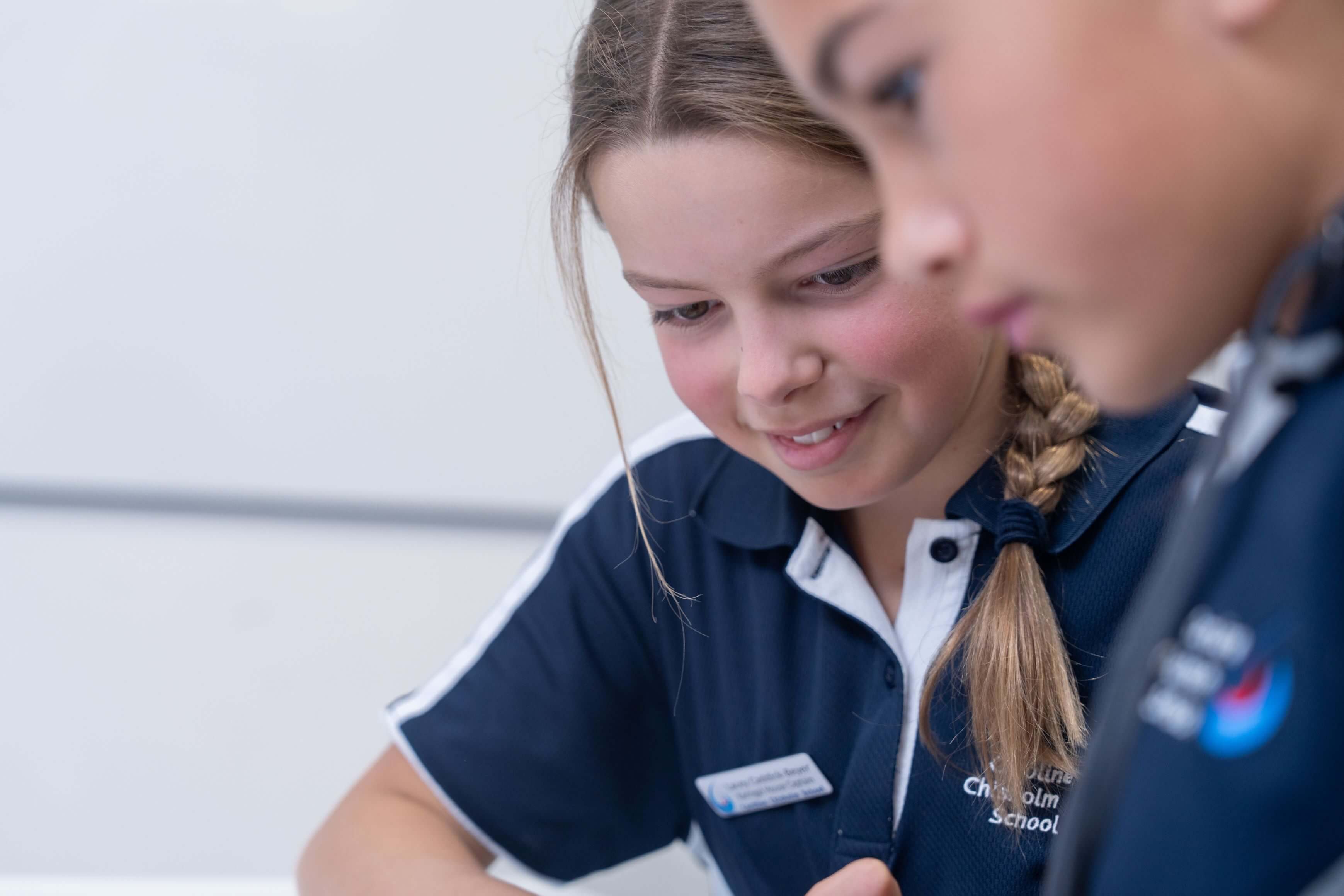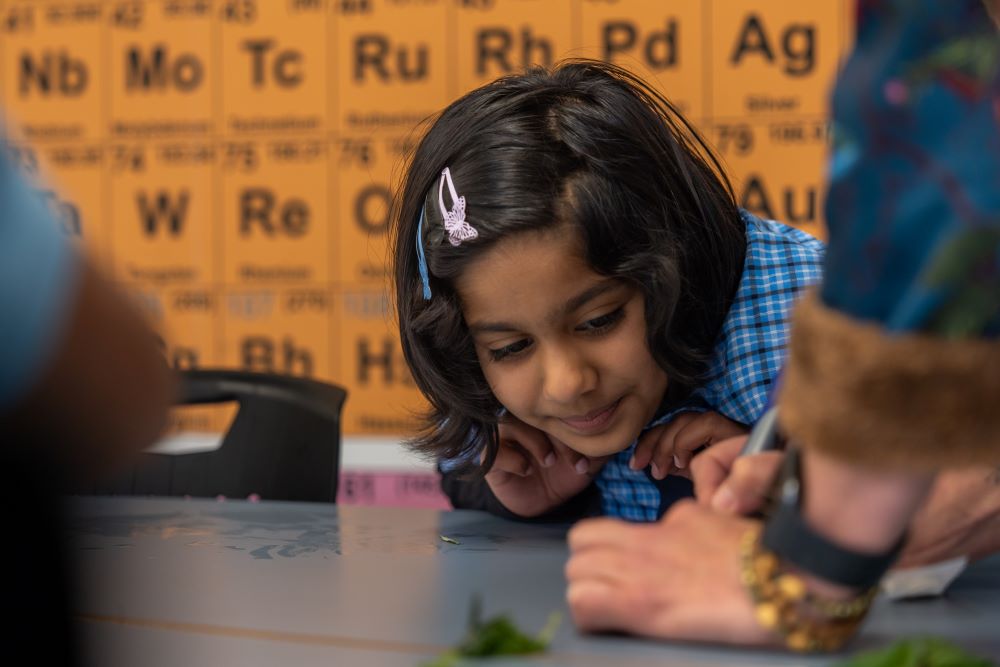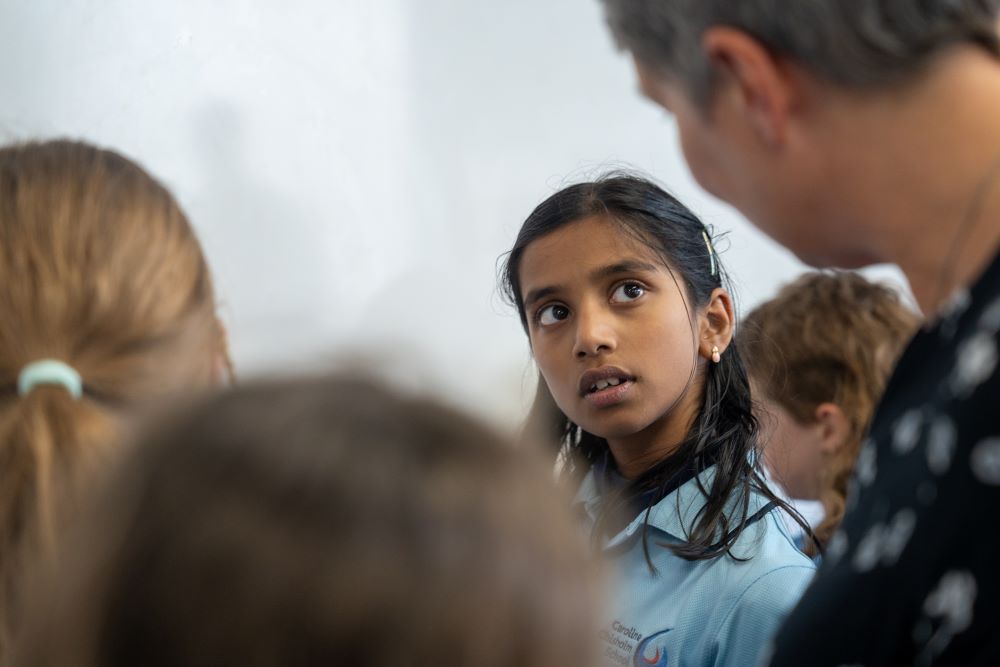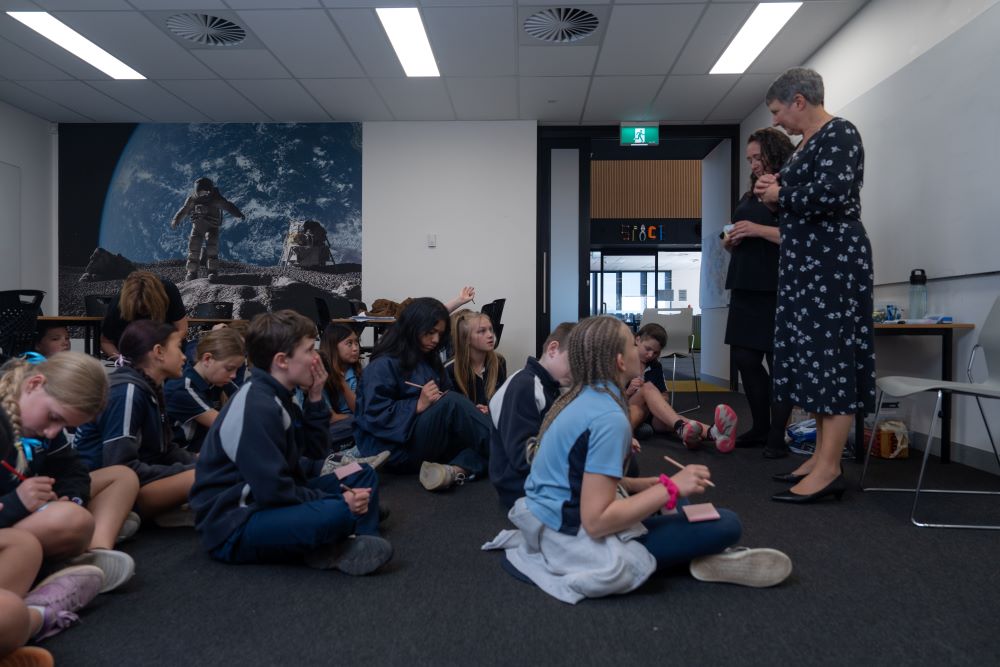Take, shape and create
View Sequence overviewStudents will:
- predict if specific materials can be changed in different ways, e.g. can wood be twisted, torn, bent, scrunched, stretched and poked?
- observe what happens to everyday materials when they are physically changed in different ways.
- describe materials as flexible and inflexible.
Students will represent their understanding as they:
- record results of their investigation in a table.
- draw a labelled diagram to represent what is happening to a material when it is physically changed.
In this lesson, assessment is formative.
Feedback might focus on:
- Are students able to explain and reason about what is unchanged about a material, even though its shape, size etc. has been changed?
- Are students able to identify where their predictions did and did not match their evidence?
- Are students connecting their observations (evidence) to their explanations?
Whole class
Class science journal (digital or hard-copy)
A variety of familiar objects made of common materials (see Preparing for this sequence)
Demonstration copy of What changes? Resource sheet
Each group
Familiar object/s (made from plastic, fabric/fibres, metal, wood, etc.) to examine
Each student
Individual science journal (digital or hard-copy)
What changes? Resource sheet
Lesson
The Inquire phase allows students to cycle progressively and with increasing complexity through the key science ideas related to the core concepts. Each Inquire cycle is divided into three teaching and learning routines that allow students to systematically build their knowledge and skills in science and incorporate this into their current understanding of the world.
When designing a teaching sequence, it is important to consider the knowledge and skills that students will need in the final Act phase. Consider what the students already know and identify the steps that need to be taken to reach the level required. How could you facilitate students’ understanding at each step? What investigations could be designed to build the skills at each step?
Read more about using the LIA FrameworkRe-orient
Recall the previous lesson, focusing on the objects that students examined and ways they suggested the objects could be changed. Refer to the ideas map or retrieval charts created.
Review the meanings of the terms 'object' and 'material' in a scientific sense.
Explain that from now on we are going to describe objects in terms of the materials they are made of, and sometimes we might need adjectives to help with our descriptions. View some of the objects available to students and name the materials they are made out of. Select two objects made of the same material and use adjectives to differentiate between the two, such as thick and thin plastic.
Note: At this stage it is acceptable for students to use everyday language such as ‘thick’ and ‘thin’ to describe the differences between materials. The following series of investigations will explore properties and introduce more scientific terminology in context.
The Inquire phase allows students to cycle progressively and with increasing complexity through the key science ideas related to the core concepts. Each Inquire cycle is divided into three teaching and learning routines that allow students to systematically build their knowledge and skills in science and incorporate this into their current understanding of the world.
When designing a teaching sequence, it is important to consider the knowledge and skills that students will need in the final Act phase. Consider what the students already know and identify the steps that need to be taken to reach the level required. How could you facilitate students’ understanding at each step? What investigations could be designed to build the skills at each step?
Read more about using the LIA FrameworkIdentifying and constructing questions is the creative driver of the inquiry process. It allows students to explore what they know and how they know it. During the Inquire phase of the LIA Framework, the Question routine allows for past activities to be reviewed and to set the scene for the investigation that students will undertake. The use of effective questioning techniques can influence students’ view and interpretation of upcoming content, open them to exploration and link to their current interests and science capital.
When designing a teaching sequence, it is important to spend some time considering the mindset of students at the start of each Inquire phase. What do you want students to be thinking about, what do they already know and what is the best way for them to approach the task? What might tap into their curiosity?
Read more about using the LIA FrameworkWhat happens when I bend it?
Refer back to any questions about how objects/materials might be physically changed. For example: How do we physically change an object? How do we scrunch, twist or bend things? What happens when we physically change (material)?
Pose the question: What happens to (material) when I bend it? Twist it? Fold it?
The Inquire phase allows students to cycle progressively and with increasing complexity through the key science ideas related to the core concepts. Each Inquire cycle is divided into three teaching and learning routines that allow students to systematically build their knowledge and skills in science and incorporate this into their current understanding of the world.
When designing a teaching sequence, it is important to consider the knowledge and skills that students will need in the final Act phase. Consider what the students already know and identify the steps that need to be taken to reach the level required. How could you facilitate students’ understanding at each step? What investigations could be designed to build the skills at each step?
Read more about using the LIA FrameworkThe Investigate routine provides students with an opportunity to explore the key ideas of science, to plan and conduct an investigation, and to gather and record data. The investigations are designed to systematically develop content knowledge and skills through increasingly complex processes of structured inquiry, guided inquiry and open inquiry approaches. Students are encouraged to process data to identify trends and patterns and link them to the real-world context of the teaching sequence.
When designing a teaching sequence, consider the diagnostic assessment (Launch phase) that identified the alternative conceptions that students held. Are there activities that challenge these ideas and provide openings for discussion? What content knowledge and skills do students need to be able to complete the final (Act phase) task? How could you systematically build these through the investigation routines? Are there opportunities to build students’ understanding and skills in the science inquiry processes through the successive investigations?
Read more about using the LIA FrameworkChanging materials
Working in collaborative teams, students select one of the provided materials.
Discuss:
- What is meant by the terms ‘scrunched’, ‘twisted’, ‘torn’, ‘bent’, ‘stretched’ and ‘poked’?
- How do we create these changes with our hands/bodies?
- What might happen to the material when it is ‘scrunched’, ‘twisted’, ‘torn’, ‘bent’, ‘stretched’ and ‘poked’?
- Does it break?
- Introduce the terms ‘flexible’ and ‘inflexible’: flexible objects do not break or tear. Inflexible objects will not bend or twist, or will break/tear when bent.
- Is the material being changed?
- When a physical change occurs, a material changes its state, appearance, or shape but remains the same material.
Demonstrate how to complete the PROE chart on the What changes? resource sheet. Students record their prediction (P) of how their material changes and their reasons (R) for these predictions in the first two columns of the PROE chart. Students might not necessarily agree on their predictions when working in a team, and this is perfectly acceptable. You might ask students to create their own PROE charts. This allows students to express different ideas if necessary, and support assessment of individual students.
Students complete the O and E sections of the PROE chart by:
- physically changing their selected material in the listed ways, recording the results and why they think that happened.
- describing the material as flexible or inflexible.
- representing their understanding by drawing a labelled diagram of the material being physically changed.
Students can repeat the activity with multiple materials if appropriate.
Collaboration
Working collaboratively can benefit students in a multitude of ways.

Collaborative learning gives students the opportunity to observe in new ways, consider multiple perspectives, and contribute to rich, evidence-based discussions.
Students can engage in reflective practice, with a focus on the General capability of Personal and social capability using the Working in teams self-assessment (WITSA) tool.
Collaborative learning gives students the opportunity to observe in new ways, consider multiple perspectives, and contribute to rich, evidence-based discussions.
Students can engage in reflective practice, with a focus on the General capability of Personal and social capability using the Working in teams self-assessment (WITSA) tool.
Predict, Reason, Observe, Explain (PROE)
PROE is a tool to engage students in the investigative process and support deep thinking.

PROE is a tool to engage students in the investigative process and support deep thinking. It affords students experience with developing argumentation skills through science inquiry, and supports you, the teacher, to monitor their thinking in order to guide the inquiry.
At this stage, student predictions will be based on their everyday experiences with the materials they are working with. They will likely be able to predict that paper will tear easily, scrunch and bend easily because they have a lot of everyday experience with this material. Students may find it more difficult to make predictions about materials that they have less experience with, or might make them by comparing an unfamiliar material with a more familiar one. These are valid ways of making predictions.
PROE is a tool to engage students in the investigative process and support deep thinking. It affords students experience with developing argumentation skills through science inquiry, and supports you, the teacher, to monitor their thinking in order to guide the inquiry.
At this stage, student predictions will be based on their everyday experiences with the materials they are working with. They will likely be able to predict that paper will tear easily, scrunch and bend easily because they have a lot of everyday experience with this material. Students may find it more difficult to make predictions about materials that they have less experience with, or might make them by comparing an unfamiliar material with a more familiar one. These are valid ways of making predictions.
Representational challenge
Providing opportunities for students to represent their understanding supports them to link ideas.

After completing their PROE, students are challenged to use their existing literacy skills to represent what they think was happening in terms of the physical changes occurring to the material. Students might include arrows to show the direction of movements that caused the physical change, or use words to describe these changes.
Providing these opportunities for representation support students to make a link from the physical change made and the force required to make the change. However, it is not necessary to be explicit with students on this point at this stage.
After completing their PROE, students are challenged to use their existing literacy skills to represent what they think was happening in terms of the physical changes occurring to the material. Students might include arrows to show the direction of movements that caused the physical change, or use words to describe these changes.
Providing these opportunities for representation support students to make a link from the physical change made and the force required to make the change. However, it is not necessary to be explicit with students on this point at this stage.
The Inquire phase allows students to cycle progressively and with increasing complexity through the key science ideas related to the core concepts. Each Inquire cycle is divided into three teaching and learning routines that allow students to systematically build their knowledge and skills in science and incorporate this into their current understanding of the world.
When designing a teaching sequence, it is important to consider the knowledge and skills that students will need in the final Act phase. Consider what the students already know and identify the steps that need to be taken to reach the level required. How could you facilitate students’ understanding at each step? What investigations could be designed to build the skills at each step?
Read more about using the LIA FrameworkFollowing an investigation, the Integrate routine provides time and space for data to be evaluated and insights to be synthesized. It reveals new insights, consolidates and refines representations, generalises context and broadens students’ perspectives. It allows student thinking to become visible and opens formative feedback opportunities. It may also lead to further questions being asked, allowing the Inquire phase to start again.
When designing a teaching sequence, consider the diagnostic assessment that was undertaken during the Launch phase. Consider if alternative conceptions could be used as a jumping off point to discussions. How could students represent their learning in a way that would support formative feedback opportunities? Could small summative assessment occur at different stages in the teaching sequence?
Read more about using the LIA FrameworkWhat have we learned?
Share and discuss results as a class. Select or emphasise comments that recognise that the shape of the material may have changed, but that the material itself was unchanged.
- What material did you change?
- How would you describe the material?
- What object was made out of that material?
- What might the object be used for?
- Who might use the object?
- Was the material able to be changed in each of the listed ways?
- What was it like before the change?
- What was it like after the change?
- What stayed the same?
- Do you think the change is permanent?
- How did the change affect the material?
- Can the material still be used for its original purpose? How? Why? Why not?
- Can it be re-used? Recycled? Repurposed?
Discuss:
- What flexible materials do you use every day?
- The clothes they wear, paper they write on etc.
- What would happen if the material was not flexible?
- When might we need materials to not be flexible?
- For example, the walls of a house.
- What would happen if walls were flexible?
- How might some of the materials examined today be used in a sculpture?
- For example, flexible materials might be good for covering the sculpture, but they might not be as good to hold other heavier materials up.
Reflect on the lesson
You might:
- add to the class word wall of vocabulary related to materials and physical changes including flexible and inflexible.
- review the questions students asked about materials and add any new questions students have.
- re-examine the intended learning goals for the lesson and consider how they were achieved.
- discuss how students were thinking and working like scientists during the lesson. Focus on the predictions they made and how accurate these predictions were. Discuss how they were able to make accurate predictions, and why some predictions might have been harder to make.
Productive science discussion
The aim of this discussion is to highlight that although materials can be changed, they are ultimately still ‘made’ up of the same things.

The aim of this discussion is to highlight that although materials can be changed, they are ultimately still ‘made’ up of the same things. A consequence of this might be that they are no longer useful for the originally intended purpose. For example, a piece of paper can be torn or cut into smaller pieces. Up unto a certain point it might still be used for its original purpose—for writing, or drawing, wrapping gifts etc. If you continue to tear or cut the paper into smaller and smaller pieces it may no longer be useful, but it ultimately remains paper. This also supports students to begin to develop an understanding of the core concept: that the properties of a substance/materials remain the same, even if the substance/material is physically changed.
The aim of this discussion is to highlight that although materials can be changed, they are ultimately still ‘made’ up of the same things. A consequence of this might be that they are no longer useful for the originally intended purpose. For example, a piece of paper can be torn or cut into smaller pieces. Up unto a certain point it might still be used for its original purpose—for writing, or drawing, wrapping gifts etc. If you continue to tear or cut the paper into smaller and smaller pieces it may no longer be useful, but it ultimately remains paper. This also supports students to begin to develop an understanding of the core concept: that the properties of a substance/materials remain the same, even if the substance/material is physically changed.